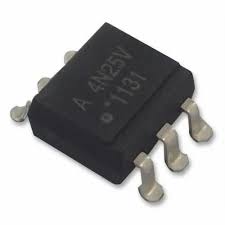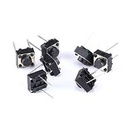4N25 transistor output optocoupler
This content will be shared across all product pages.
Description:
The 4N25 is an optocoupler device that combines an infrared emitting diode (IRED) and a NPN phototransistor in a single 6-pin DIP package. It provides electrical isolation between input and output circuits, allowing control signals to be transmitted without direct electrical connection. The optocoupler is commonly used for interfacing low voltage control signals with higher voltage loads, making it suitable for applications such as switching power supplies, motor controls, industrial controls, and signal isolation.
Key Features:
- Optically coupled isolator
- Infrared emitting diode (IRED) and NPN phototransistor
- High isolation voltage: 5000 Vrms (minimum)
- Low input current requirement
- High current transfer ratio (CTR)
- Compact 6-pin DIP package
- RoHS compliant
- Package Type: 6-pin DIP
- Isolation Voltage: 5000 Vrms (minimum)
- Forward Voltage (V_F): Typically 1.2V at 10mA forward current
- Collector-Emitter Voltage (VCEO): 30V
- Power Dissipation (P_D): 250mW
- Operating Temperature Range (T_OP): -40°C to +85°C
- Storage Temperature Range (T_STG): -55°C to +150°C
- Soldering Temperature (T_SOL): 260°C for 10 seconds
- Signal isolation in control systems
- Microcontroller interfacing
- Switching power supplies
- Industrial automation
- Motor controls
- Consumer electronics
Technical Specifications:
- Logic Family: CMOS
- Number of Channels: 3
- Switch Configuration: Single-Pole Double-Throw (SPDT)
- Supply Voltage Range: 3V to 15V
- “ON” Resistance (R_ON): 125Ω typical at V_DD = 10V
- “OFF” Leakage Current (I_OFF): ±100pA typical at V_DD = 10V
- Control Input Voltage (V_IH): 0.7 V_DD min, 0.3 V_DD max
- Maximum Operating Frequency: 40 MHz at V_DD = 10V
Applications:
- Signal routing and switching
- Analog and digital multiplexing
- Audio and video signal processing
- Data acquisition systems
- Test equipment


